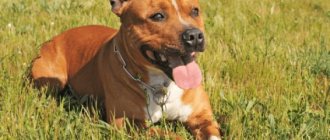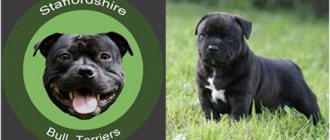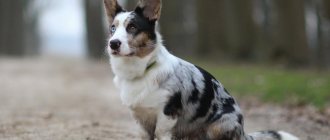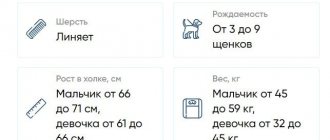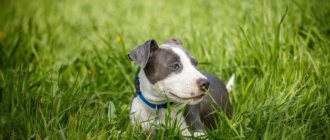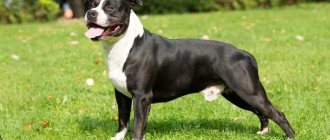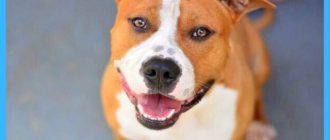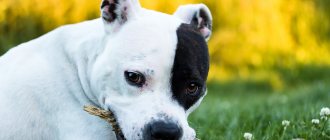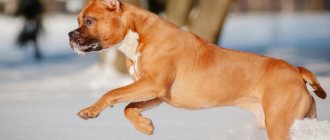Description of the Staffordshire Bull Terrier breed
Popularity 17th among 263 dog breeds
Lifespan:
12-14 years old
Breed group:
Fighting
Height:
35.5-40.5 cm
Country of origin:
Great Britain
Average price:
10-25 thousand rubles
Weight:
males: 12.7-17 kg, females: 11-15.4 kg
Latest articles Cat health
Rabies vaccination for cats: choice of vaccine, necessity, schedule 01/22/2022 15 0 0
Selection and adaptation
TOP 20 best cat breeds for families with children 01/22/2022 27 0 0
Key facts
The description of the Staffordshire breed allows other names: Staffies, Staffbulls, Bull and Terriers. Staffs are not aggressive at all. Due to their small size, they are perfect for apartment living. A big plus of the breed is the absence of long hair, which does not require special attention. Good health and immunity are some of their main advantages. This also includes the high life expectancy of the Staffordshire Bull Terrier.
The appearance of dogs dates back to the 19th century. In some English county of Staffordshire, they began to be bred to participate in bull baiting hunts. These dexterous, strong and incredibly hardy animals coped well with their main hunting task.
Bull and Terriers have a unique and inimitable appearance. Everything about them is perfect: a sweet face, a deep look, a well-coordinated body constitution, and the frisky nature of their movements. They have a capricious, sometimes very stubborn character. However, the characteristics of the Staffordshire Bull Terrier breed say that with proper training, puppies grow into obedient companions capable of performing even the most difficult tasks.
They are very smart, so every training session with your pet turns into an exciting game. During training, they instantly grasp new material. But from time to time, moments of stubbornness arise, to which it is important for the owner to respond correctly. The four-legged creature must understand that they are dissatisfied with him and that his behavior is unacceptable.
Pros and cons of the breed
Like any other dog breed, the English Staffordshire Bull Terrier has both positive and negative qualities.
| Advantages | Flaws |
| Love for children | Inability to cope with street conditions |
| Lack of aggression towards people | Need for physical activity |
| Low maintenance | Tendency to dominate |
| Compactness |
The Staffordshire Bull Terrier is a strong, determined and courageous dog. Compact size, high intelligence, friendliness towards people and a cheerful disposition make the dog an excellent companion.
But despite his balance and kindness, the English Staff Bull is always ready to fight back against the offender. Therefore, it is impossible to purposefully develop aggression in a Staffie.
History of the origin of the Staffordshire Bull Terrier
The beginning of the 19th century in England was the time of the appearance of another type of entertainment - dog fighting. In the gateways, dog owners pitted the animals against each other and received money for the performances. This has become a kind of new kind of “animal sport”. The English poor wanted a spectacle, the key element of which were dogs with massive body proportions, medium-length paws and a wide muzzle.
Some of the first participants were only bulldogs, then terriers. Over time, people became bored with such fights, since experts guessed in advance the next actions of the experimental animals. The poor wanted a more brutal show. To maintain a constant source of income, the dog owners decided to create an ideal fighting breed for this kind of show, experimenting with the genetics of four-legged dogs.
Months later, bull and terriers appeared in the rings, which were obtained by mating a bulldog with an English terrier. Representatives of the new breed came out strong and very dexterous. They differed from their ancestors in their instinct to catch mice. So, they started feeding rats to show the staff, receiving large fees for this. In the 20s of the 20th century, the public rejoiced at the dog Billy, who strangled about a hundred rodents in a few minutes.
Further, the breeding of bull terriers acquired a spontaneous, absolutely free character. Breeders continued experiments on the external characteristics of individuals. This is how three groups of dogs appeared:
- Cradleys are the smallest bull and terriers;
- Warlastons are fairly well-fed medium-sized dogs with short legs;
- Varson - individuals with long legs.
Since the 50s of the 19th century, four-legged fighters have acquired their current appearance features. It was only in the mid-30s that their exterior standard was established. This happened after dog fighting was banned in England. The Cradley group has become the standard of the breed.
Similar dog breeds
Ca-de-bo
American Staffordshire Terrier
Boerboel
American Pit Bull Terrier
Walk
The Staffordshire Terrier needs good but moderate exercise. Puppies under one year old should not get tired after a walk or training area. In cold or hot weather, you should walk your animals for no more than 15 minutes twice a day. Adult dogs, especially males, need to be walked much longer than females.
Important! According to the law, dogs of this breed require a mandatory muzzle. Therefore, it is worth accustoming the animal to this subject. Sometimes you should let your pet run freely on a training ground or on a walk in the forest.
Stafford muzzled
Appearance of the Staffordshire Bull Terrier
General impression
Staffies are broad-chested, robust breeds with smooth coats and hard bones. They are similar to pit bulls and amstaffs. However, Staffbulls are noticeably different from their distant relatives. They have a number of features that clearly distinguish them from other breeds.
Their main features are a wide smile and small stature with a rather muscular body outline.
Head
The large, compact skull is spherical in shape, with a clearly prominent stop. The short muzzle is noticeably smaller than the size of the head. Dogs have a well-developed grasp reflex due to the characteristic activity and strength of the jaw muscles. The bite should be tight. They have large white teeth and a correct bite. The nose is strongly extended forward. The ears of staffbulls resemble the falling leaves of trees in shape and position.
The rounded eyes are positioned in proportion to the nose, set straight. The iris is usually dark in color. Individuals with a lighter shade of fur have bright colors of the iris.
Neck
The short neck is a feature of the breed. Because of this, the dogs look more plump and shorter. According to exterior standards, there should be no folds on the neck.
Torso
The muscular large body has a slightly elongated shape: this is clearly visible in the profile photo of the Staffordshire Bull Terrier. It is tightly built, the top of the body is larger than the pelvic part. These four-legged beauties are distinguished by their even posture and dense croup. The stomach is tucked. Deep chest of wide condition.
To enlarge the sternum of a growing pet, many owners purchase a harness with a weight - a leather accessory with lead weights. It is hung around the puppy’s neck from the age of one or one and a half years. This method of increasing pectoral muscle mass is suitable for dogs that cannot run uphill or exercise on a regular basis.
Forelegs
The elongated front legs are set wide apart and the shoulder blades are pulled back. Dogs have strong wrists and dense fingers. A large distance between the limbs is considered a deviation.
Hind limbs
The hind legs are stronger, the shins are located at a distinct angle. Strongly built hips help you push off the ground when running or jumping. Moderately long metatarsals (the middle section of the supporting part of the paws) are parallel to each other, in other words, there is no clubfoot.
Tail
The tail of Bull Terriers is quite short and straight. It does not curl and is set low.
Movements
Pets move quickly, quickly responding to commands or some external stimuli. They are very active, run fast and dodge. The movements clearly show a characteristic boldness, as well as a certain imposingness. When dogs are overexcited, their behavior may exhibit aggression that is unusual for companion breeds.
Wool
The fur is quite short and very smooth. It evenly covers the entire body. Dogs have no undercoat. A loose, soft coat is considered a deviation from appearance standards. Wavy or too long fur is also considered a defect.
Color
The colors of the Staffordshire Bull Terrier can be light, cream, or brown, even black. A uniform color is accepted as the norm, as well as wool with different patterns or spots on certain parts of the body.
1.If the color is black, there are no stains. The nose is also dark, and the eyes have a brown tint.
2. The red or red color should be evenly distributed throughout the body.
3. Fawn color is considered the most beautiful, giving an elegant appearance to the pet.
4. Against a red background, tiger patterns or coatings in the form of dark blurry spots on the nose, mouth, ears or limbs are often found.
There are dogs with a white color. In this case, the exterior must have spots all over the body.
Size
The height of male Staffordshire bull terriers (height at the withers) is about 46-48 cm with an average standard weight of up to 30 kg. Females weigh 24-26 kg with a height of 44-46 cm. The weight of the Staffordshire Bull Terrier should be on the bones and muscles; obesity is unacceptable.
The size of the Staffordshire Bull Terrier allows it to be kept in an apartment, but only if it is actively walked.
Appearance: big in small
American cocker and English cocker spaniel: differences
Description of the Staffie breed:
- the appearance creates a double impression: they are both large and graceful, elegant dogs;
- males are distinguished by their larger size than females (up to 20 kg, compared to 15 kg), as well as highly developed muscles;
- The height of the animal at the withers is on average about 40 cm;
- the coat is hard, short, without undercoat;
- ears stick out and droop slightly;
- eyes are round, vary in color, depending on coat color;
- the bite is correct;
- the tail is small, tapered towards the end.
Staffordshire Bull Terrier competition winner
Coat and possible colors
The wool fits tightly to the skin and can serve as a kind of protection in battles. Coat colors that meet the standards:
- amber;
- ginger;
- predominant light;
- blue (gray);
- black.
Important! A mixture of shades is possible, but there should be no more than two. For example, the presence of white spots against the general background will not be considered a defect. But other colors are a sign of disqualification.
Blue staff
Personality of the Staffordshire Bull Terrier
Dogs have a very peaceful, good-natured, even playful character. They have inherited fighting traits that practically do not manifest themselves in everyday behavior. Their appearance does not correspond to their behavioral characteristics, since the dogs look like true fighters, but behave like calm domestic companions.
Staffies are very loyal to their owners. It is important for them to receive enough attention and care. Communication with a loved one is the highest value.
Representatives of this breed perceive other animals with suspicion and get along with other domestic animals for a long time. Bull Terriers are always ready to stand up for themselves or their people, they love to chase cats, but this is just for fun. Aggression occurs in the rarest circumstances or in animals with mental disorders.
Many owners limit their pets' communication with other animals. However, it is important for animals to be among their own kind. Thanks to this, dogs develop a healthy, stable psyche.
Staff Terriers are not suitable for people who love spending time at home, as these four-legged creatures love long walks, active games, and prolonged contact with humans. They love children, willingly play with them, patiently enduring even the most unpleasant pranks. The character of the Staffordshire Bull Terrier as a whole does not correspond to its fearsome appearance.
How children are treated
The attitude of Staffordshire Bull Terriers towards children is a big plus for the representatives of the breed. They are always affectionate and tactful with kids. Moreover, they love absolutely all children, not only those who live in the house. Dogs love to play with children on the playground, they trust them very much, they love it when children caress them and scratch their tummy.
Important! In such communication, it is worth watching not for the dog, but rather for the child, who can hit the dog and hurt it. But even in this case, representatives of the Staffie breed will not return evil for evil.
Education and training
The fighting roots even in such cute creatures must be pacified. This will require patience, strength, as well as a great desire of the owner to raise the animal into a true friend, companion and protector. The main tasks are the education and training of the Staffordshire Terrier, as well as early socialization.
If you don’t start learning the basics in time, the dog will cause a lot of inconvenience to the owner in the future. These bull terriers are not aggressive, but this does not mean that they are absolutely harmless and that there is no need for strict education from an early age.
“General training course” (GTC) is the most suitable option for representatives of this breed. The course “Controlled City Dog” (UGS) is a simpler version of OKD. These programs include a number of commands that the dog must know and accurately execute. For Staff Bulls, it is recommended to undergo the “Protective Guard Service” (PSS), but not required.
Bull Terriers are stubborn, but if you are patient and clearly indicate the dog’s tasks, then after some time of training your pet will understand the need to fulfill the requirements. The main thing is not to become rude or angry. Such behavior will only complicate the relationship between the trainer and the pupil.
An important basis for training is a clear understanding of the authority of the owner. Professional trainers advise paying attention to developing the skill of instantly executing assigned tasks. There is no need to say the command a second time. Staffs are natural manipulators, so during training, dog handlers recommend strictly standing your ground.
Puppies are initially accustomed to their own nickname, trying to often call the pet and pronounce the nickname during games or petting. At two and a half months, the puppies are already quite ready to go outside.
It is better to divide hour-long training lessons into five-minute intervals, that is, every five minutes you allow your four-legged baby to take a break from training. The method will help maintain interest in learning. Given this fact, try to devote one or two lessons to learning each command. Don't forget to repeat them in the future.
The most basic tasks that a little friend must learn are to respond to a call by name, bring a small object, and follow the owner on a walk without pulling on the leash. After memorizing these commands, you can move on to more complex ones.
Staffordshire Bull Terrier Health and Diseases
In general, dogs are in good health. With proper care, proper feeding, as well as the constant presence of sincere affection and communication, individuals are in excellent physical and emotional condition.
Possible diseases
Due to their short fur in winter, four-legged friends are susceptible to colds. Dietary disorders are the causes of ailments that occur in the gastrointestinal tract. Diseases to which staff bulls are most susceptible:
- urolithiasis;
- volvulus;
- ectropion - eversion of the mucous membrane of the cervix;
- hip dysplasia;
- cataract;
- Cushing's syndrome is a disorder of metabolic processes in the body.
The breed is also characterized by patelloluxation (impaired functioning of the musculoskeletal system, in particular the hind limbs). Some nurseries conduct litter testing for this subject. This helps identify abnormalities by stopping the breeding of affected dogs. There are also different tests for detecting hereditary cataracts, genetic epilepsy, L-2-OH-hydroxyglutaric aciduria (metabolic disorders).
Puppies must be vaccinated. 12 weeks after birth they are vaccinated against rabies, and at the age of five months they are vaccinated against other infections. Bull Terriers are usually given vaccines against the following diseases:
- distemper;
- hepatitis;
- enteritis.
According to the rules, they are vaccinated in three approaches, every 3-4 weeks. The procedures should be repeated every year. The average lifespan of dogs is 13-15 years.
Reproductive health
Monitoring the condition of your pet's reproductive system is very important. As soon as the baby teeth are replaced, the bitches enter puberty and come into heat.
At this moment, you should watch the female more closely. Hormonal maturation is characterized by restless, inattentive, and sometimes angry behavior. Estrus is divided into three main stages:
1. Proestrus (7-10 days) – the stage of egg maturation. During this period, the dog experiences frequent urges to go to the toilet, marks its territory, and experiences increased interest in males.
2. Estrus – release of the egg (9-10 days after the appearance of discharge). The bitch begins to allow the male to approach her.
3. Metaestrus (lasts about 11 days) – reduction of the loop to standard sizes. The discharge stops and the general condition of the individual is restored.
4. Anestrus (4-5 months) – the stage of a calm state.
A few days before the appearance of discharge, the bitch’s mammary glands swell, her appetite and behavior change. During the period of heat, it is advisable to keep notes, indicating the stages, briefly describing the condition of the animal - if you plan to breed your bitch.
Delays may occur due to unsuitable living conditions, abnormalities of the reproductive organs, inflammatory processes or other problems in the body. One-time deviations appear due to stress, heavy workload, and also due to prolonged colds.
Veterinarians recommend breeding a female dog after 2-3 heats. Staffbulls do not have a common hormonal maturation process.
During the period of the first heat, you should treat your pet leniently, do not punish for failure to comply with all commands, and sometimes there are puddles on the floor. The dog experiences stress, and the body becomes very vulnerable. During this period, you should avoid drafts, swimming, avoid long walks, and stop training for a while.
If you do not plan to breed puppies, a reasonable solution would be to sterilize your pet, that is, ligation of the ovaries or seminal ducts in male dogs. Castration is an operation to remove reproductive organs. If, after sterilization, the four-legged creature still has instincts to mate, then after castration these signs completely disappear.
Mating
The breed is not large, mating for the Staffbull is standard. They don't require a lot of space or special recommendations, but it is worth inviting a knowledgeable person, especially during the first denouement. It will help not only pets, but also owners.
Bullies become sexually mature at 10 months. But it is recommended to breed only from 20-25 months, when both the male and female are able to conceive and bear strong offspring. Days 13-15 from the start of the third heat are considered favorable. At this time, the loop loosens, the discharge becomes lighter, and the female becomes playful or aggressive.
If the dogs are pedigree, have status and have pedigree documents, then they need to be bred through a kennel. Namely, get a certificate and fill out the form. The owners agree in advance on the date and price, which is set by the owner of the male. Usually it is equal to one puppy or a percentage of its cost (depending on the number of heads in the litter).
Animals need to be walked together and introduced to them. This takes 15-20 minutes . Then the girl is brought to the territory of the male dog. This is necessary for the male to feel confident. It is believed that if a boy gets used to “home” matings, he will not look for a “bride” on the side.
Read a detailed article on the topic: “Everything you need to know about breeding dogs: appropriate age, what to do if it doesn’t work out, rules and tips.”
If the female is satisfied with everything, she will allow the cage to be mounted. Sexual intercourse does not last long – 10-15 minutes. At this time, the girl should be held by the head and under the stomach, and the boy should be guided into the noose. After several active shocks, a lock should occur. If it didn’t happen, it doesn’t mean that the bitch is empty. Repeated mating is carried out after 2 days.
Features of feeding and diet
Puppies are fed 5-6 times a day. From the 4th month - 4 times, from 6 months - 3 times a day, and from 1 year - 2 times. The diet of an adult Bull Terrier mainly includes:
- easily digestible proteins: fermented milk products, cottage cheese, boiled sea fish fillet, turkey or chicken meat, lean beef, rabbit;
- porridge;
- vegetables and fruits.
As for vegetables, representatives of this breed love boiled cabbage. But you should not give it often, as this causes increased gas formation. Favorite fruits are apples.
It is allowed to give offal about twice a week. Due to the low content of nutritional components in them, the portion is increased by 10-15 grams, that is, instead of 30 grams of meat - 40-45 grams of tripe.
It is better to choose premium or super-premium industrial food without purchasing cheap dry food in regular stores. Veterinarians do not recommend mixing homemade food with store-bought food.
The diet of puppies is insignificant, but differs from the diet of an adult. Beef, rabbit, some fruits, vegetables, very hard and heavy cereals are best given from six months. All products are introduced gradually in small quantities, observing the animal’s reaction, its appetite, daily stool and allergic reactions.
Care and maintenance
Representatives of this companion breed do not require much space to live. Despite their super mobility, they do not cause much trouble to maintain. The main thing is to allocate a place with a soft pillow or bedding, give several toys: balls, squeakers, small ropes, rubber accessories. They will help to release energy, get rid of stress, and will also be useful in training.
Wool does not require special care, which is a big plus. During seasonal shedding in spring and autumn, dogs are well combed with brushes or special mittens with spikes. There is no need to carry out this procedure constantly.
Animals are usually bathed once every month. After water treatments, it is important to dry the fur well and wipe the paws dry. Once a day, you should pay attention to the eyes of Bull and Terriers, removing dirt and tear deposits from the corners. You can wipe with a cotton swab dipped in chamomile solution to prevent conjunctivitis. It is advisable to inspect the ears weekly, removing wax with a damp cotton pad.
Dogs' teeth require special attention. It is necessary to clean the mouth with a brush three times a week, and sometimes give special bones with mineral supplements to maintain the health of the cavity. It will be enough to carefully straighten the claws 1-2 times a month with scissors, then file them with a file. Before the dog pedicure procedure, you can steam the nail plate in warm water. This will make it easier to remove the keratinized part.
The basic rules for caring for and maintaining a Staffordshire Bull Terrier are simple and do not require grooming skills from the owner.
How to choose the right puppy?
To be sure that the English Staff Bull will grow up absolutely healthy, you need to purchase the animal only from a professional breeder or in a specialized nursery.
Before buying a staffie, you should carefully study the dog’s documents and evaluate the conditions of detention. By looking at one of the parents of small staff bulls, you can get a rough idea of how the puppies will grow up.
On a note. Good breeders start selling their litter no earlier than a month and a half later. At this age, English Staffy puppies have already been certified and have all the necessary documents. Babies eat on their own and adapt more easily to a new place.
A healthy Staffy puppy has a shiny coat, soft belly, clear eyes and clean ears. There are no rashes or scratches on the baby's body. The little Staffbull is active, curious and shows no signs of cowardice or aggression.
Tips for choosing a puppy
Staffordshire Bull Terrier puppies, like adult animals, are very playful, active, and sometimes overly active. Children who are too calm, even with some inhibited reactions, arouse suspicion. Aggressive behavior is also not typical for them.
Males are larger, denser, and slightly more active than females. Bitches are more affectionate, they become attached to people very quickly.
The place where animals are kept must be clean, without any strong or foreign odors. Upon request, bona fide breeders are required to show documents confirming purebred blood and the absence of genetic diseases.
Character and behavior
The English Staffordshire Bull Terrier is a friendly and cheerful dog. The Staffbull has never shown aggression towards people. And the breeders suppressed hostility towards their own kind in staffies.
Expert opinion
Leonid Rodin
Experienced dog breeder
Ask a Question
In fact, all statements about the intolerable character of the Staffordshires and their uncontrollable aggression are amateurish fantasies devoid of any factual confirmation. The fleeting fashion for owning these unique four-legged animals led to the fact that animals began to fall into the hands of owners unprepared for owning such a serious dog. The owners did not make enough efforts to socialize their pets and only developed anger in them. Meanwhile, many world celebrities have been spotted among fans of the Staffordshire Bull Terrier breed. They live in the homes of TV presenter Rachel Ray, actor and director Kevin Bacon, film star Jessica Alba, and Oscar nominee Linda Blair. Over the years, the staff accompanied Rebecca Corry, Rachel Bilson, Miranda Lambert, Cesar Millan and Jon Bernthal. To a large extent, it was with the help of star owners that Staffordshire dogs managed to restore their true peace-loving reputation in the eyes of ordinary dog lovers.
The English Staffbull is kind to children. The dog is well aware of his own power and plays very carefully with the weak.
An energetic and active Staff Bull has a stable psyche and high intelligence. He is very obedient, silent and smart. Staffy quickly becomes attached to his owners and does not tolerate loneliness well.
On a note. A Staff Bull that is left unattended for a long time begins to misbehave. A bored dog can chew furniture and damage the owner's property.
How much does a Staffordshire Bull Terrier cost?
The average cost of a healthy purebred puppy from interbreeding is 50-70 thousand rubles. Pets from less famous parents cost about 30-40 thousand rubles.
Also, the price of a Staffordshire Bull Terrier depends on color. Red puppies are the most expensive, they cost at least 25 thousand rubles. The price for brindle-colored babies starts from 5 thousand. Black and white or blue and gray can be bought for at least 10 thousand rubles.
Do you like the article? 0
Predisposition to diseases
Despite the fact that the Staffordshire Bull Terrier dog breed is famous for its good health, they still have a predisposition to certain diseases. These include:
- heart disease;
- deafness;
- dislocation of the kneecap;
- tracheal collapse;
- nephropathy;
- arthrosis;
- pylorospasm.
Staffordshire Bull Terriers often have acquired diseases such as:
- dermatitis;
- kidney diseases;
- oncological diseases;
- injuries of the musculoskeletal system.

